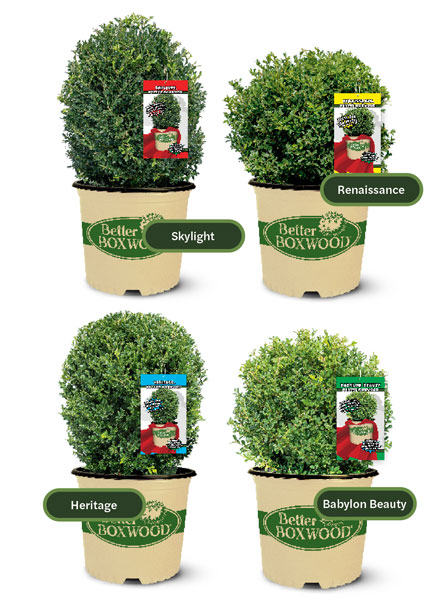12/1/2024
Building a Better Boxwood
Jennifer Polanz

Leaf spot. Stem cankers. Leaf drop. These are the symptoms of boxwood blight, a fungal disease that landscapers and homeowners began seeing on boxwood plants around the northeastern U.S. more than 10 years ago. The disease causes mass defoliation and plant losses, in some places even decimating historic boxwoods that had thrived for 150 years. As boxwood blight continued to spread to many eastern and midwestern states it was clear a solution was needed.
Belgian plant breeder Didier Herman, owner of Herplant BV, was already on the case. Europe had been dealing with boxwood blight since the 1990s, and Didier went back to the origins of the species for a solution, said Kip McConnell, vice president of business development for Plant Development Services. “(He) collected around 200 species and cultivars and tried more than 150 crossing combinations. His evaluation process of seeking maximum blight resistance yielded a trial size of 10,000 seedlings. From that pool of 10,000, the four Better Boxwood varieties were selected.”
These four Better Boxwood varieties were introduced by Plant Development Services to the U.S. and Canadian markets this year, and Kip said it was the collection’s hybrid vigor that set it apart from the beginning. It wasn’t just the blight resistance, they also had improved performance in both colder and hotter regions as compared to other boxwoods (they are hardy to USDA Zones 5 to 9) and were adaptable to a range of soil types, as well as offered unique attributes specific to each variety.
For example, Skylight is a fast-growing variety that is ideal as a large hedge (it can get upwards of 6 to 8 ft. tall and 3 to 4 ft. wide) and has deep green foliage. Strong roots support vigorous growth, and it’s an optimal choice for shaping and pruning.
Heritage, meanwhile, is a more traditional boxwood that makes for a great mid-sized hedge or topiary, maturing to 3 to 4 ft. tall and 2 to 3 ft. wide. It has rich green foliage.
On the petite side, Renaissance is the most dwarf variety in the collection and is suitable for parterre (patterned gardens) and knot gardens. It only reaches 1 to 2 ft. tall and 1 to 2 ft. wide at maturity, and is easy to prune into a ball or box (Kip said it also requires less pruning as it’s a slower-growing variety).
And finally, another vigorous variety with strong roots, Babylon Beauty features a lighter green foliage and thrives in poorer soils. It’s still compact at 3 ft. tall and 4 to 5 ft. wide.
“If a customer had previously lost a boxwood to blight or storms, we knew that restoring confidence in the shrub meant offering a resilient product with unique traits and exceptional hardiness,” Kip said. “We’re delighted to have found those traits in Better Boxwood. The varieties are heat-tolerant in areas of the deep South where previous boxwood varieties have struggled, and they display impressive cold-hardiness, showing minimal winter bronzing, when tested in Zone 5.”
The goal for Plant Development Services, too, is to provide retailers with the tools they need to reassure customers they can return to buying boxwoods without concern. The company offers a range of resources, including free merchandising tools that ship to retailers such as flexible signage like aisle markers and a whole “store-within-a-store” concept. The website, www.betterboxwood.com, does a lot of the heavy lifting, offering customers information and a store locator, while retailers can use it to find growers to order from and the point-of-purchase resources described above.
“Our comprehensive marketing campaigns, which span traditional advertising, social media partnerships and public relations, reach over a billion consumers annually,” Kip said. GP